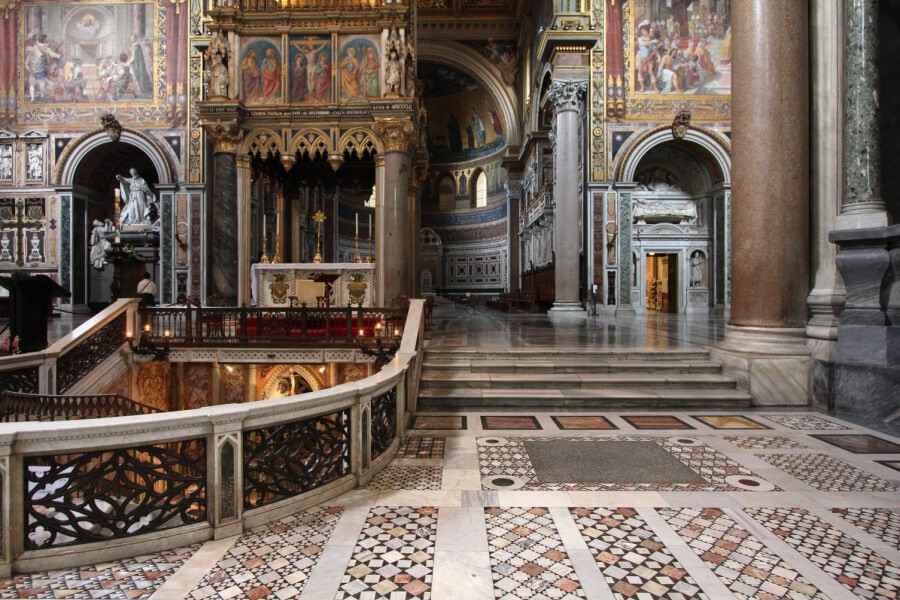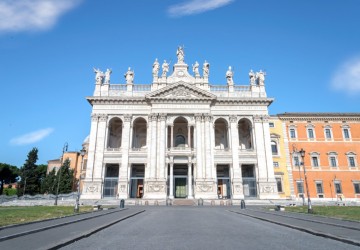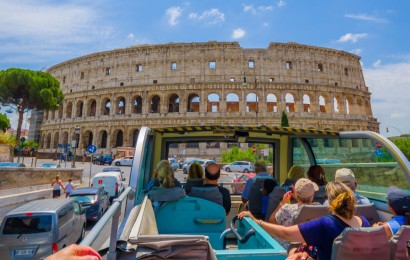The Basilica of St. John Lateran (also known as the Cathedral of Rome) is the first of the four major papal basilicas (Basilica of San Giovanni in Laterano, Basilica of San Pietro in Vaticano, Basilica of San Paolo fuori le mura, Basilica of Santa Maria Maggiore).
The Basilica is located on the Hill of Celio and is the oldest, as well as the first to which it has been awarded the title of basilica and is therefore called "archbasilica". More precisely, he has the honorary title of Omnium Urbis et Orbis Ecclesiarum Mater et Caput, which means "Mother and Head of all the Churches of the City and of the World".
This Basilica, for its beauty and its historical importance, is undoubtedly an essential destination for tourists and pilgrims from all over the world.
→ Discover its beauty and its history with our tour of Christian Rome
When was the Basilica of St. John Lateran built?
The Basilica of San Giovanni in Laterano was built in the fourth century in the Horti Laterani, an ancient land possession of the Lateran family, confiscated during the empire of Nero.
In the area where the basilica was built, Marcus Aurelius built a residential building in the year 161 and Emperor Septimius Severus used part of the confiscated land for the construction of a large military complex called Castra nova equitum singularium, or New Barracks of the Chosen Guards.
The land and the palace reached the emperor Constantine when he married in 307 Fausta, daughter of the ex-emperor Maximian. According to tradition, it was Constantine who, following the victory of the Battle of Ponte Milvio (312 AD), had the Basilica built near the palace as a sign of recognition towards Christ.
The Basilica was consecrated in 324 by Pope Sylvester I who dedicated it to the Most Holy Christ the Saviour. In the 9th century, Pope Sergius III also dedicated it to Saint John the Baptist, while in the 12th century, Pope Lucius II also added Saint John the Evangelist. In fact the real name of the church is Basilica of the Most Holy Saviour and of Saints John the Evangelist and John the Baptist.
The interior of the Basilica of St. John Lateran

Originally the Basilica was known as the Golden Basilica and received continuous donations from emperors, popes and other benefactors.
The Basilica over the centuries was repeatedly damaged by vandalic attacks, looting and earthquakes, and restored.
Its total reorganization was made by Francesco Borromini who created here one of his highest masterpieces, reconstructing the entire nave and the side.
Among the most famous works of the Basilica of San Giovanni in Laterano we have the fresco by Giotto depicting Pope Boniface VIII in the act of holding the first Jubilee of 1300, the coffered ceiling of the central nave designed by Pirro Ligorio and decorated by Daniele da Volterra and the cosmatesque floor.
The Cloister of the Lateran
The Cloister was built in the first half of the thirteenth century. by the famous Roman marble Pietro Vasselletto.
Measuring 36 meters per side and is, in fact, the largest cloister in the capital.
Inside the Cloister there are numerous sculptures and ornaments including some works by Arnolfo di Cambio and a copy of the bull of Gregory XI on the primacy of the Archbasilica.
In the middle of the inner garden courtyard is the 9th century Samaritan Well.
Holy and Sancta Sanctorum Staircase
The Pontifical Shrine of the Holy Staircase is among the most illustrious in the Catholic world. It is located at the Basilica of San Giovanni in Laterano and houses the chapel of the Popes called Sancta Sanctorum, where the image of SS. Salvatore (called Acheropìta, or not painted by hand of man).
The Sancta Sanctorum is one of the best examples of Gothic art in Rome.
The chapel housed many and most venerated relics of saints defined "the holy things among the saints", the sancta sanctorum precisely. For this reason, the chapel, originally dedicated to San Lorenzo, in the ninth century was called Sancta Sanctorum.
Under the papal altar, there are two bronze doors that cover the cypress ark made by Leo III and containing the treasure and the relics of the Sancta Sanctorum. These are showcases, crosses, pyxes, fabrics, embroidery, parchments, miniatures, enamels, of incalculable value.
You can reach the "Chapel of San Lorenzo" or "Sancta Sanctorum" through the Scala Santa, built by Pope Nicholas III in 1278. The heart of Christianity, the Scala Santa , is composed of 28 steps of white marble, those that, according to tradition, were walked by Christ to go to Pontius Pilate on the day of his death sentence. And for this call Scala Santa.
The steps, according to tradition, were brought to Rome in 326 from Jerusalem at the behest of Saint Helena, mother of the Emperor Constantine.
The steps lead to the chapel and they must have gone up on their knees out of veneration for the Passion of Jesus.
The Piazza di San Giovanni in Laterano
The beautiful Basilica of San Giovanni in Laterano is located on the Piazza di Porta San Giovanni, one of the most important squares in Rome.
At the center of the square is the oldest and tallest obelisk in the city (31 meters), made of red granite, which was located in the temple of Ammon in Thebes, near Luxor.
At the foot of the obelisk, the Fontana dell'Acqua Felice, built in 1588 by Domenico Fontana.
San Giovanni in Laterano, some curiosities
If you are curious we will reveal some details you may not know about the Basilica of San Giovanni in Laterano:
- A peculiarity of the basilica is connected to an acoustic effect.
Between one arch and the other, leaning on the colonnade, you can confide something to another interlocutor leaning on the opposite side without anyone hearing you; - The Basilica is linked to a curious and macabre event.
One of the most dramatic events in the history of the Catholic Church was held in the Basilica: the trial of Pope Formosus (known as the Synod of the Corpse).
After his death in 896, his successor, Stephen VI, instructed a trial against him, accused of having risen to the papal throne supported by pro-German factions.
The mummy of Formosus was then exhumed from the tomb and placed on a throne in the council room to answer all the accusations made by Pope John VIII.
The verdict established that the pontificate had been unlawful and all the orders he had given were declared invalid. In addition, the papal garments were torn from his body, cut off the three fingers of his right hand (used by the Pope for the consecrations). The body was then thrown into the Tiber.
In the same year a terrible earthquake severely damaged the church: the event was considered a divine punishment against Stephen VI and required a profound restoration of the Basilica.

